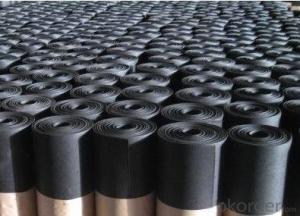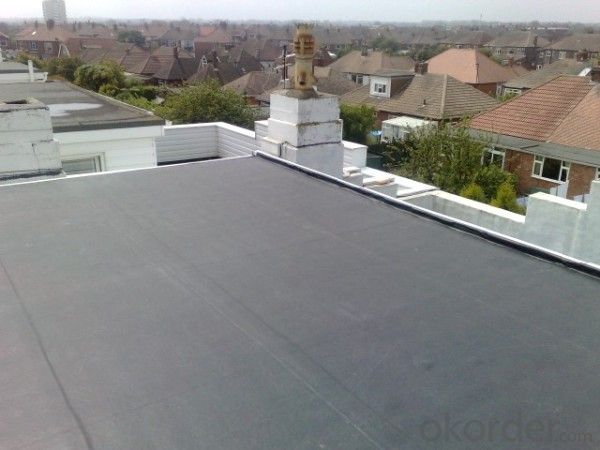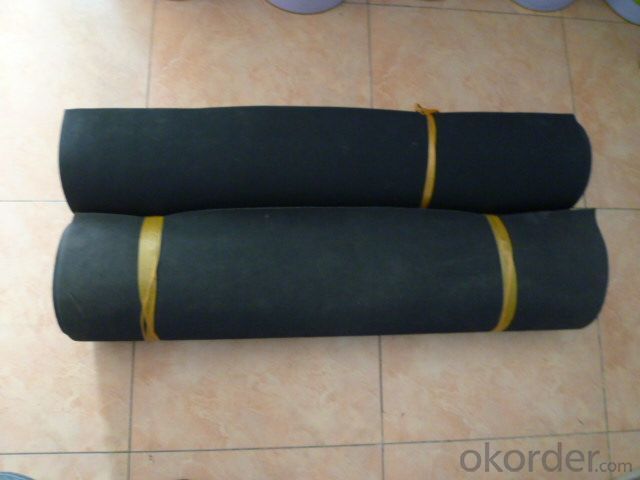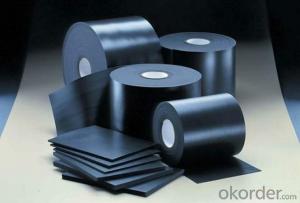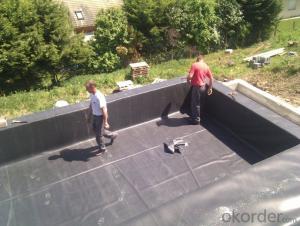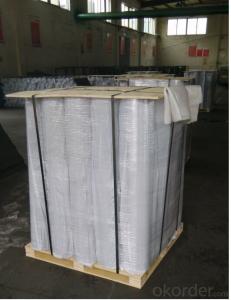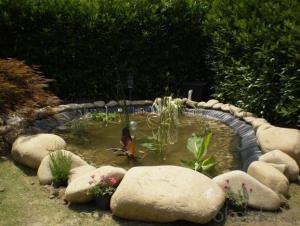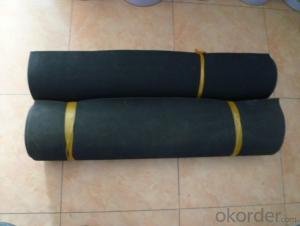EPDM Waterproofing Membrane with Customized Widths
- Loading Port:
- Shanghai
- Payment Terms:
- TT OR LC
- Min Order Qty:
- 50000 m²
- Supply Capability:
- 5000000 m²/month
OKorder Service Pledge
OKorder Financial Service
You Might Also Like
EPDM Waterproofing Membrane with Customized Widths
Description Of EPDM Waterproofing Membrane with Customized Widths:
·Filament polyester filler base sheet material:
·The combination of filament polyester filler base and SBS modified bitumen forms an excellent comprehensive performance and high quality waterproof sheet material;
·High strength waterproof layer and strong water pressure resistance;
·Good performance of breaking resistance, tearing resistance, fatigue resistance, corrosion resistance, mould resistance and weather resistance;
·High tensile strength, high elongation, high adaptive capacity to base shrinkage deformation and fracture;
·Good resistance performance of low and high temperature: It could still work under -20℃ , be applicable to cold and hot regions, especially in chilly region;
·Good workability: It can be constructed by heat fusion method in the four seasons of the whole year and hot-joint is reliable and durable.
·Alkali-free glass fiber filler base sheet material:
·Combination of economical filler base and high performance SBS modified bitumen.
·Higher tensile strength, excellent resistance to high and low temperature.
·Good performance of corrosion resistance, mould resistance, weather resistance and good workability.
·Glass fiber reinforced polyester filler base sheet material:
·It is safe and eco-friendly by using mechanical mounting of construction.
·The product has better dimensional stabiliy.
Main Features of EPDM Waterproofing Membrane with Customized Widths:
EPDM rubber waterproof membrane can operate in single layer, and is characterized by light weight, ageing resistance, with long service life, great tensile strength and high extension coefficient, which has strong adaptability to shrinkage, cracking and deformation in basic level. It can work well within -40°C to 100 °C and can be constructed with a single layer in ambient temperature. The service life of EPDM rubber waterproof membrane is up to 50 years, which is known as "King of Waterproof".
Specifications of EPDM Waterproofing Membrane with Customized Widths:
Type | EPDM Rubber Waterproof Membrane | ||
Type | Vulcanized and Weldable | ||
Thickness | 1.2mm | 1.5mm | 2.0mm |
Weight(kg/m2) | 1.54-1.58 | 1.79-1.83 | 2.25-2.29 |
Size | 1.2m (width) * 20m (length)/roll. Weldable type could be 4m wide. | ||
Packing | 24㎡/roll, with plastic bag. (Weldable: 80㎡/roll) | ||
Usage | Roof, basement, pond, Lake, steel structure roofing, underground, tunnel, etc | ||
NO. | Item | Unit | Technical requirement | |
1 | Tolerance on size | Thickness | % | ±10 |
Width | % | ±1 | ||
length | % | Does not allow negative | ||
2 | Fracture tensile strength (normal temperature ) | Mpa | ≥7.5 | |
Fracture tensile strength(60 ℃) | Mpa | ≥2.3 | ||
3 | Breaking elongation,(normal temperature ) | % | ≥450 | |
Breaking elongation,(-20 ℃) | % | ≥200 | ||
4 | Tearing resistance | KN/m | ≥25 | |
5 | Impermeability | * | 0.3Mpa impermeable | |
6 | Bending at low temperature | °C | ≤-40 | |
7 | Elongation and contraction volume at heating | Elongation | mm | ≤2 |
contraction | mm | ≤4 | ||
8 | Hot air aging 80°CX168h | Fracture strength retention | % | ≥80 |
Rate of elongation at break | % | ≥70 | ||
9 | Alkaline (saturated Ca(OH)2 solution normal Temperature x2 168h ) | Fracture strength retention | % | ≥80 |
Rate of elongation at break | % | ≥80 | ||
10 | Ozone aging (40 degree by 168 hours ) | Elongation 40% , 500x10-2 | * | No Crack |
11 | Phytotron aging | Fracture strength retention | % | ≥80 |
Rate of elongation at break | % | ≥70 | ||
Applications of EPDM Waterproofing Membrane with Customized Widths:
Widely used in roofs, basement, toilet ,swimming pool, and all kinds of industry and civil building waterproofing, reservoir, vivicism, bridge, underground, tunnel and dam waterproofing ,especially to the keystone waterproofing projects which is durability, high corrosion resistance and easy deformation.

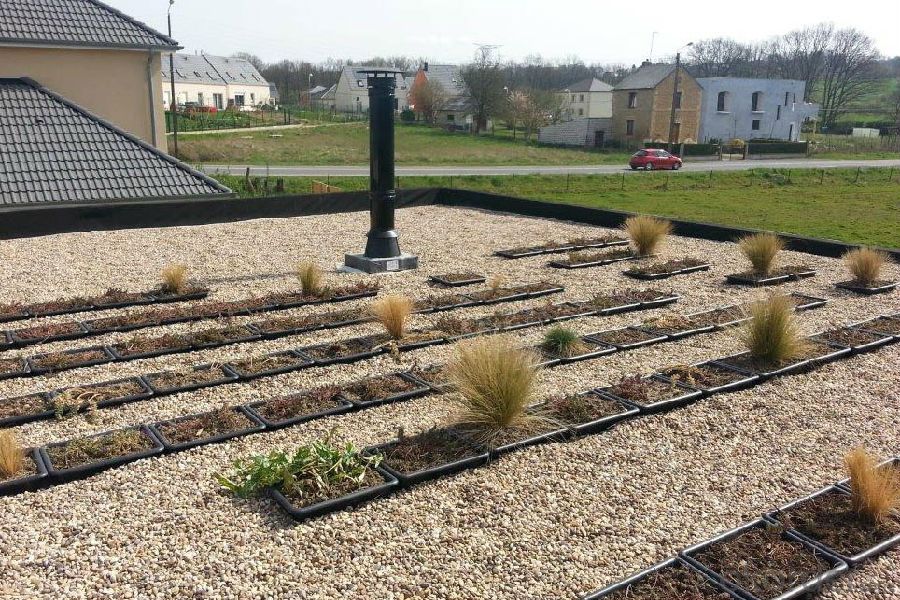

IMages of EPDM Waterproofing Membrane with Customized Widths:
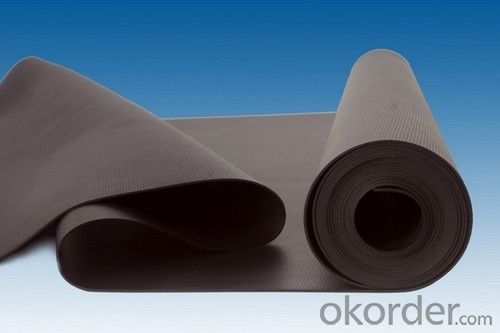
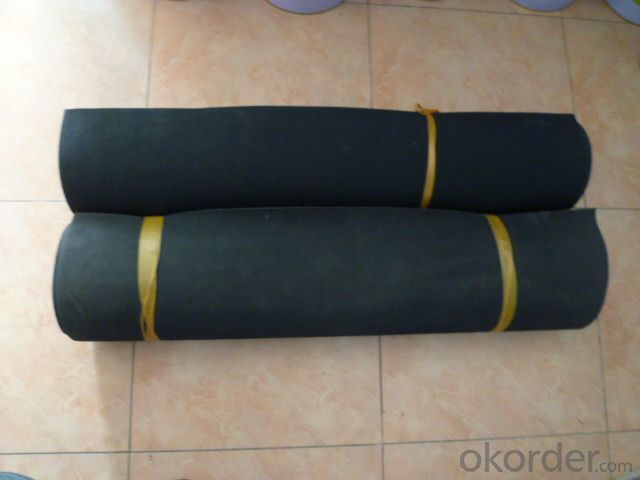


FAQ of EPDM Waterproofing Membrane with Customized Widths:
1. What are we supplying?
We are specialized in producing Colorful Asphalt Roof Shingle, SBS/APP modified bitumen waterproof membrane, Self adhesive bitumen waterproof membrane, PVC waterproofing membrane, EPDM rubber roofing membrane, Single Component Polyurethane Waterproof Coating, and Spray Polyurea Waterproof Coating
.
2. How Many years experience do we have?
We have been exported to more than 20 countries in the past 15 years.
3. How long do we usually reply your request?
We always reply our customer within 24 hours.
- Q: Can a waterproofing membrane be used on tunnels with fire protection systems?
- Yes, a waterproofing membrane can be used on tunnels with fire protection systems. The waterproofing membrane is designed to provide protection against water ingress, while the fire protection system is designed to prevent or minimize the spread of fire. These two systems can be installed and utilized together to ensure the safety and integrity of the tunnel infrastructure.
- Q: What are the potential drawbacks or limitations of using a waterproofing membrane?
- One potential drawback of using a waterproofing membrane is the potential for improper installation. If the membrane is not installed correctly, it can lead to leaks and water damage. It requires a certain level of expertise and attention to detail to ensure that the membrane is properly applied and sealed. Another limitation is that waterproofing membranes can be relatively expensive compared to other waterproofing methods. The cost of purchasing and installing the membrane, as well as any necessary maintenance or repairs, can add up quickly. This may make it less feasible for some budget-conscious individuals or organizations. Additionally, waterproofing membranes are not a one-size-fits-all solution. Different types of membranes are suitable for different applications, and it is important to choose the right one for the specific requirements of the project. This requires knowledge and understanding of the various options available, which can be a challenge for those without experience in the field. Another potential drawback is the limited lifespan of waterproofing membranes. Over time, they can deteriorate or become damaged, which may require replacement or repairs. This can be costly and time-consuming, especially if the membrane needs to be removed and replaced in order to fix the issue. Lastly, waterproofing membranes are primarily used for below-grade applications or on horizontal surfaces such as roofs or decks. They may not be as effective for vertical surfaces such as walls or in areas where there is significant movement or stress, such as expansion joints. In these cases, alternative waterproofing methods may be more suitable. In summary, while waterproofing membranes offer excellent protection against water intrusion, they also come with potential drawbacks and limitations such as improper installation, high cost, need for expertise in selection, limited lifespan, and limitations in application. It is important to weigh these factors and consider alternative options before deciding on a waterproofing solution.
- Q: Can a waterproofing membrane be used on steel surfaces?
- Indeed, steel surfaces can benefit from the application of a waterproofing membrane. These membranes are specifically designed to establish a shield against moisture and water incursion, and they possess the versatility to be utilized on a range of surfaces, including steel. Construction endeavors, including roofs, balconies, and foundations, frequently feature steel surfaces. By employing a waterproofing membrane on these steel surfaces, one can effectively thwart corrosion and harm arising from water contact. It is crucial to carefully choose a waterproofing membrane that suits steel surfaces, while also adhering to correct surface preparation and application techniques to attain maximum performance and longevity.
- Q: Does a waterproofing membrane provide any additional structural reinforcement?
- No, a waterproofing membrane does not provide any additional structural reinforcement. Its primary purpose is to prevent water penetration and protect the underlying structure from moisture damage. Structural reinforcement typically requires other methods such as steel reinforcement, concrete additives, or structural members like beams and columns.
- Q: Can a waterproofing membrane be used in geotechnical applications?
- Yes, a waterproofing membrane can be used in geotechnical applications. Waterproofing membranes are commonly used to prevent the infiltration of water into structures and are applied to various surfaces such as roofs, basements, and foundations. In geotechnical applications, these membranes can be utilized to prevent water from seeping into soil, preventing erosion, and stabilizing slopes. They can be installed horizontally or vertically to create a barrier that prevents water penetration, which can be particularly useful in retaining walls, embankments, and dams. Additionally, waterproofing membranes can also be used to control the flow of water and improve drainage in geotechnical projects. Overall, the use of a waterproofing membrane in geotechnical applications can enhance the durability and performance of structures while protecting against water-related issues.
- Q: Can a waterproofing membrane be used for food processing facilities?
- Yes, a waterproofing membrane can be used for food processing facilities. Waterproofing membranes are commonly used in various industries, including food processing, to ensure protection against water penetration and moisture damage. In food processing facilities, where hygiene and cleanliness are of utmost importance, waterproofing membranes can be applied to floors, walls, and ceilings to prevent water or other liquids from seeping into the building structure. Waterproofing membranes create a protective barrier that effectively seals the surfaces, preventing the growth of mold, mildew, and bacteria that can contaminate food products. They also help in maintaining a clean and dry environment, reducing the risk of slips, falls, and accidents caused by wet surfaces. Food processing facilities often deal with water-intensive processes such as cleaning, washing, and sanitizing, making it crucial to have a reliable waterproofing system in place. Additionally, waterproofing membranes can offer resistance to chemicals, oils, and other substances commonly used in food processing, ensuring long-term durability and protection. It is important to note that when selecting a waterproofing membrane for a food processing facility, it is necessary to choose a product that complies with industry standards and regulations. The membrane should be food-grade and certified safe for contact with food products to avoid any potential contamination risks. Overall, using a waterproofing membrane in food processing facilities can help maintain hygienic conditions, protect the building structure, and ensure compliance with health and safety regulations.
- Q: How thick is a typical waterproofing membrane?
- A typical waterproofing membrane can vary in thickness depending on its intended application and the specific product being used. However, most commonly used waterproofing membranes range from 0.5 millimeters (mm) to 2 millimeters (mm) in thickness. Thinner membranes are often used for interior applications such as shower installations, while thicker membranes are typically used for exterior applications such as roofs or underground structures. It is important to consult the manufacturer's recommendations and specifications to ensure the appropriate thickness is selected for the specific waterproofing project.
- Q: Can a waterproofing membrane be used on storage tanks?
- Yes, a waterproofing membrane can be used on storage tanks to prevent water leakage and protect the tank from corrosion.
- Q: Can a waterproofing membrane be used for basements and crawl spaces?
- Yes, a waterproofing membrane can be used for basements and crawl spaces. In fact, it is highly recommended to use a waterproofing membrane in these areas to prevent water damage and moisture issues. A waterproofing membrane is a thin layer of material that is applied to the walls and floors of a basement or crawl space to create a barrier against water and moisture. This helps to keep the area dry and prevent water from seeping into the space, which can cause structural damage, mold growth, and other problems. Waterproofing membranes are designed to be durable and long-lasting, providing a reliable solution for protecting basements and crawl spaces from water intrusion.
- Q: How to distinguish whether the waterproofing membrane is polyester tires?
- Polyester tires (polyester fabric, polyester felt, polyester linoleum fabric) with high strength, high extension and puncture resistance, light weight, high tensile strength, good permeability, high temperature, anti-freeze, anti-aging, corrosion. Technical requirements, including the appearance of quality, intrinsic quality assessment projects and internal quality reference project, the indicators are in line with the provisions of the waterproof standards. Routine project tests should be in accordance with national standards test methods, thermal stability, bending, impregnation, water resistance test methods have done a detailed test.
Send your message to us
EPDM Waterproofing Membrane with Customized Widths
- Loading Port:
- Shanghai
- Payment Terms:
- TT OR LC
- Min Order Qty:
- 50000 m²
- Supply Capability:
- 5000000 m²/month
OKorder Service Pledge
OKorder Financial Service
Similar products
Hot products
Hot Searches
Related keywords
